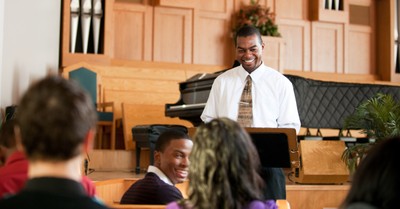So what’s happening in the “worship wars” these days? Terry Mattingly provides one answer in a column called FM Radio Reality in Church, which describes how one megachurch in California manages to put together three “radically different services” each week. Conventional wisdom suggests that nothing divides a church more than music styles.
"But High Desert Church is the kind of church that has turned this equation around. Its goal is to build a multi-flock ministry that unapologetically offers all rock, all the time, but with bands that appeal to different packs of young people, as well as bands for believers from an earlier g-g-g-generation or two."
Here are three services:
"High Desert Church offers a “Classic” service for Baby Boomers and others who came of age during the “Jesus rock” explosion in the ’60s and ’70s. This service offers a softer brand of acoustic rock — think Byrds or the Eagles — that is easier on the delicate and even damaged ears of older worshippers, said Crandall."
"Meanwhile, other musicians focus on the “Harbor” service for people between the ages of 30 and 50. It features the kind of soaring, inspiring rock that most people would associate with U2 and classic bands from the 1980s. Then the “Seven” service cranks things up another notch, with what Crandall described as a “dark” and “moody” mix of postmodern music for the young."
What about the so-called “blended” service that attempts to mix various styles? The article suggests it won’t work in most churches because it offers just enough to frustrate everyone–a little Fanny Crosby, a little Chris Tomlin, a little Twila Paris, a little Martin Luther, a little pipe organ, a choir number, a praise band, and so on.
A few questions come to mind:
1) How many different worship experiences can a church offer without losing the core unity of the congregation?
2) How do we distinguish between giving people what they want and what they really need and how is that determined?
3) What have we lost in not passing along the rich heritage of evangelical hymns and gospel music? Does it matter?
4) If you were starting a new church today, how would you determine what sort of music you would use?
5) Does this sort of “generational” worship branding mean that the church will end up changing its whole worship approach every few years? Does that matter?
6) Is “blended” worship working in many places?
7) How much of this might be called natural generational change and how much represents a deeper theological shift in terms of how we do church?
Mattingly closes his column with a quote from the senior pastor:
“This is reality,” he said. “Everything is about the music. When you go to the mall, you can even tell what kind of people are supposed to be shopping in the different stores just by listening to the music that is playing. Can you imagine kids wanting to shop in a store that is playing the music that their parents listen to? No way.”
One final question. Is he right when he says, “Everything is about the music”?
Click here to offer your comments.
You can reach the author at ray@keepbelieving.com. Click here to sign up for the free weekly email sermon.



















